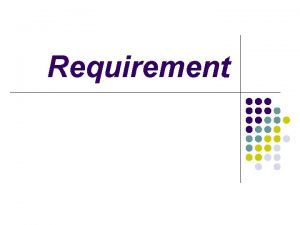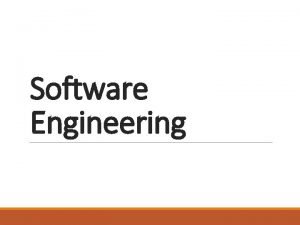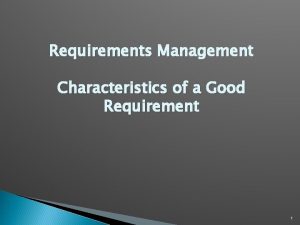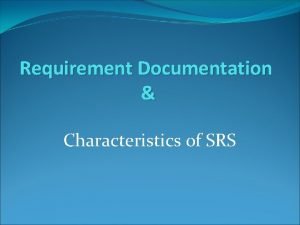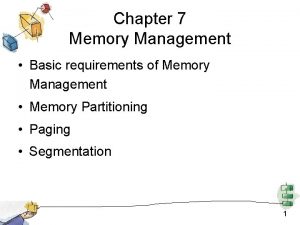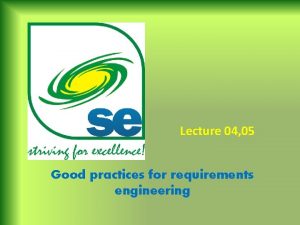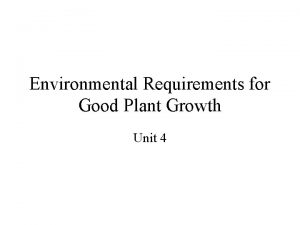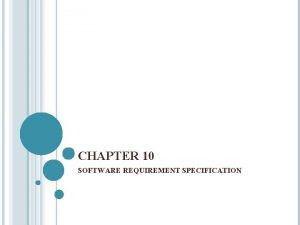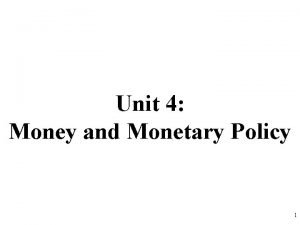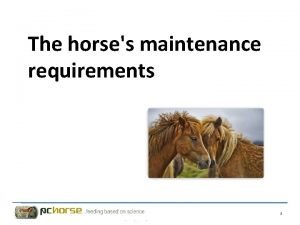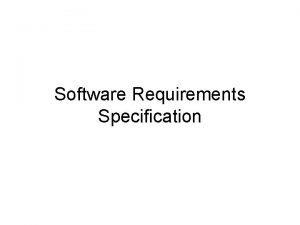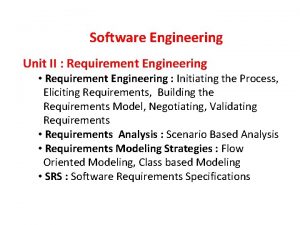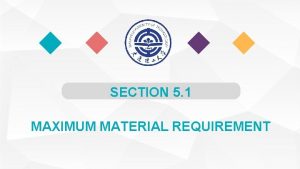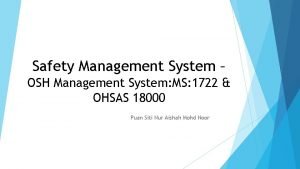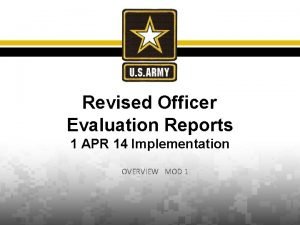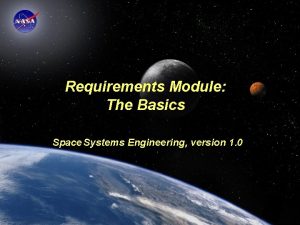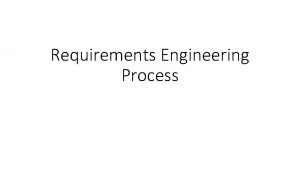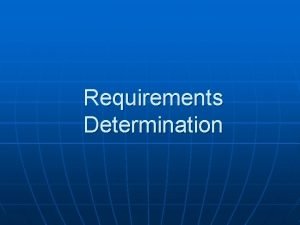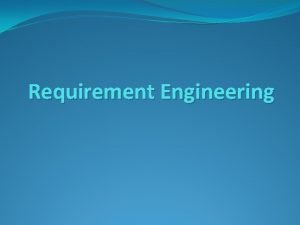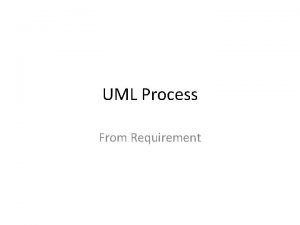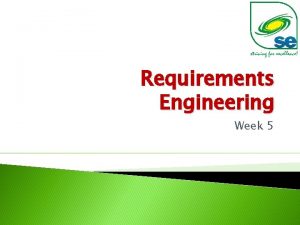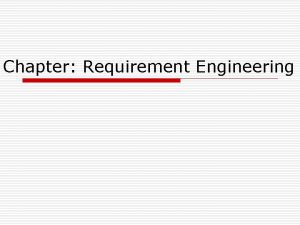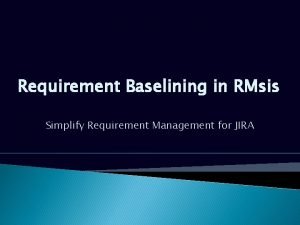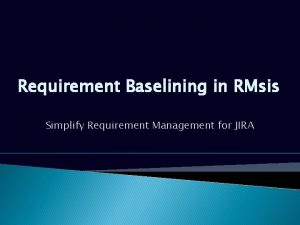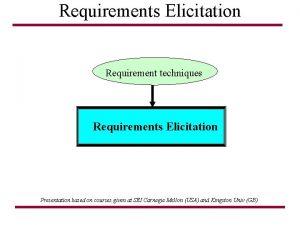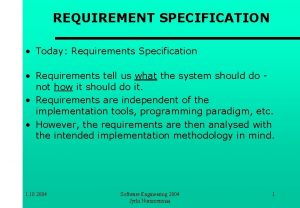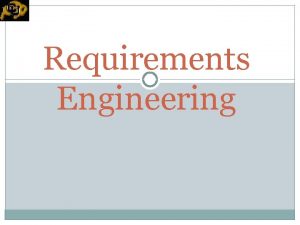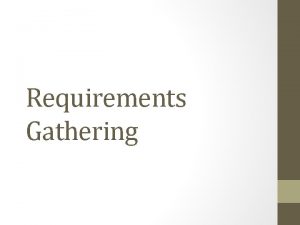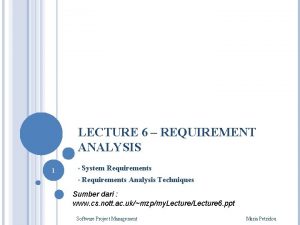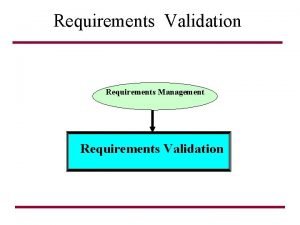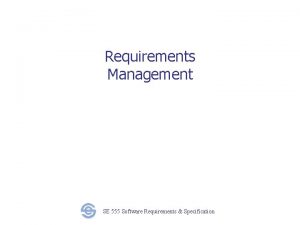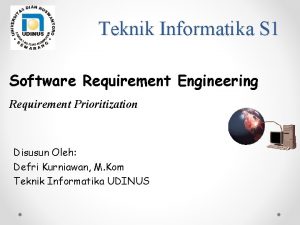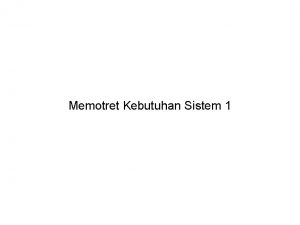Requirements Management Characteristics of a Good Requirement 1


![Software applications Used: � Step 1 : Software Requirement specification[ Rational Requisite Pro ] Software applications Used: � Step 1 : Software Requirement specification[ Rational Requisite Pro ]](https://slidetodoc.com/presentation_image_h2/bd0688b495bcd6d6d73aef61de7bb504/image-3.jpg)




























- Slides: 31

Requirements Management Characteristics of a Good Requirement 1

CIS 245 Software Engineering Lab � This lab accompanies the software engineering course to support the content in the course. The overall goals of this lab are to introduce examples of CASE tools that are used in the different software development stages. Students will learn tools from requirement, design and testing stages. Programming tools and skills will not be introduced perfectly in this lab as they are expected to have a separate lab 2
![Software applications Used Step 1 Software Requirement specification Rational Requisite Pro Software applications Used: � Step 1 : Software Requirement specification[ Rational Requisite Pro ]](https://slidetodoc.com/presentation_image_h2/bd0688b495bcd6d6d73aef61de7bb504/image-3.jpg)
Software applications Used: � Step 1 : Software Requirement specification[ Rational Requisite Pro ] � Step 2 : Software Design [Rational Rose 2002] � Step 3 : Software testing [ Using NUnit] 3

Step 1 Rational Requisite. Pro 4

A Requirement �A requirement is defined as “a condition or capability to which a system must conform. ” � It can be any of the following: ◦ A capability needed by a customer or user to solve a problem or achieve an objective ◦ A capability that must be met or possessed by a system to satisfy a contract, standard, specification, regulation, or other formally imposed document ◦ A restriction imposed by a stakeholder 5

The concept of a stakeholder � Stakeholder is defined as someone who is affected by the system that is being developed. � The two main types of stakeholders are users and customers. ◦ Users are people who will be using the system. ◦ Customers are the people who request the system and are responsible for approving it. � Usually customers pay for the development of the system. 6

The concept of a stakeholder � It is important to distinguish between these two groups of stakeholders because sometimes requirements provided by both groups conflict. � In most of these types of conflicts, customer requests take precedence over user requests. 7

The concept of a stakeholder � Here are some of the people who may be considered stakeholders: ◦ Anyone participating in the development of the system (business analysts, designers, coders, testers, project managers, deployment managers, use case designers, graphic designers) ◦ Anyone contributing knowledge to the system (domain experts, authors of documents that were used for requirements elicitation…etc) ◦ Executives (the president of the company that is represented by customers) ◦ People involved in maintenance and support ◦ Providers of rules and regulations (i. e Gov) 8

Requirements Pyramid � The requirements can be split into different requirement types. Here are some requirement types that are often used in projects. ◦ Stakeholder need: a requirement from a stakeholder ◦ Feature: a service provided by the system, usually formulated by a business analyst; a purpose of a feature is to fulfill a stakeholder need ◦ Use case: a description of system behavior in terms of sequences of actions 9

Requirements Pyramid ◦ Supplementary requirement: another requirement (usually nonfunctional) that cannot be captured in use cases (i. e. security, safety…) ◦ Test case: a specification of test inputs, execution conditions, and expected results ◦ Scenario: a specific sequence of actions; a specific path through a use. ØThese requirement types can be presented in the form of a pyramid, as shown in following Figure. 10

11

Requirements Pyramid � The main difference between needs and features is in the source of the requirement. ◦ Needs come from stakeholders, and features are formulated by business analysts. � The role of test cases is to check if use cases and supplementary requirements are implemented correctly. 12

Traceability between Requirements � Traceability is a technique that provides a relationship between different levels of requirements in the system. � Every need usually maps to some features. 13

Traceability between Requirements ◦ For example, a need can be: "Data should be persistent”. ◦ The feature can refine this requirement to be: "System should use a relational database“. ◦ On the supplementary specification level, the requirement will be even more specific: "System should use Oracle 9 i database". The further down, the more detailed the requirement. � Exercise: Give an example 14

Traceability between Requirements � Another example: ◦ A stakeholder need: “Enable the Supplier to submit the catalogue via electronic means” ◦ The feature is: “The system must support a service which facilitates the submission of e-Catalogue by Suppliers. This interface must be available to external systems. ” 15

Characteristics of a Good Requirement �A requirement needs to meet several criteria to be considered a “good requirement” 16

Characteristics of a Good Requirement � Unambiguous � � � � Testable (verifiable) Clear (concise, terse, simple, precise) Correct Understandable Independent Atomic Necessary Implementation-free (abstract) 17

Characteristics of a Good Requirement � Consistent � Nonredundant � Complete 18

Unambiguous � There should be only one way to interpret the requirement. Sometimes ambiguity is introduced by undefined acronyms. � REQ 1: The system shall be implemented using ASP. � REQ 2 : The system shall not accept passwords longer than 15 characters. � REQ 3: On the “Stored Flight” screen, the user can only view one record. 19

Cont. . � REQ 1: The system shall be implemented using Active Server Pages (ASP). (i. e. ASP may stands for Application Service Provider too). � REQ 2: The system shall not accept passwords longer than 15 characters. If the user enters more than 15 characters while choosing the password, an error message shall ask the user to correct it. � REQ 3: On the “Stored Flight” screen, the system shall display only one flight. 20

Testable (Verifiable) � To be testable, requirements should be clear, precise, and unambiguous. ◦ REQ 1 The search facility should allow the user to find a reservation based on Last Name, Date, etc. � Some words can make a requirement untestable ◦ Some adjectives: robust, safe, accurate, effective, efficient, expandable, flexible, maintainable, ◦ reliable, user-friendly, adequate ◦ Some adverbs and adverbial phrases: quickly, safely, in a timely manner ◦ Nonspecific words or acronyms: etc. , and/or, TBD 21

Clear (Concise, Terse, Simple, Precise) � Requirements should not contain unnecessary verbiage or information. They should be stated clearly and simply: � REQ 1 Sometimes the user will enter Airport Code, which the system will understand, but sometimes the closest city may replace it, so the user does not need to know what the airport code is, and it will still be understood by the system. � This sentence may be replaced by a simpler one: � REQ 1 The system shall identify the airport based on either an Airport Code or a City Name. 22

Correct � If a requirement contains facts, these facts should be true: � REQ 1 Car rental prices shall show all applicable taxes (including 6% state tax). � The tax depends on the state, so the provided 6% figure is incorrect 23

Understandable � Requirements should be grammatically correct and written in a consistent style. � The word “shall” should be used instead of “will, ” “must, ” or “may. ” 24

Independent � To understand the requirement, there should not be a need to know any other requirement: ◦ REQ 1 The list of available flights shall include flight numbers, departure time, and arrival time for every leg of a flight. ◦ REQ 2 It should be sorted by price. � The word “It” in the second sentence refers to the previous requirement. However, if the order of the requirements changes, this requirement will not be understandable. 25

Atomic � The requirement should contain a single traceable element: ◦ REQ 1 The system shall provide the opportunity to book the flight, purchase a ticket, reserve a hotel room, reserve a car, and provide information about attractions. � This requirement combines five atomic requirements, which makes traceability very difficult. � Sentences including the words “and” or “but” should be reviewed to see if they can be broken into atomic requirements. 26

Necessary �A requirement is unnecessary if: • None of the stakeholders needs the requirement. or • Removing the requirement will not affect the system. � REQ 1 All requirements specified in the Vision document shall be implemented and tested. 27

Implementation-free (Abstract) � Requirements should not contain unnecessary design and implementation information: � REQ 1 Content information shall be stored in a text file. 28

Consistent � There should not be any conflicts between the requirements. � REQ 1: Dates shall be displayed in the mm/dd/yyyy format. � REQ 2: Dates shall be displayed in the dd/mm/yyyy format. 29

Nonredundant � Each requirement should be expressed only once and should not overlap with another requirement ◦ REQ 1 A calendar shall be available to help with entering the flight date. ◦ REQ 2 The system shall display a pop-up calendar when entering any date. 30

Complete �A requirement should be specified for all conditions that can occur. ◦ REQ 1 A destination country does not need to be displayed for flights within the U. S. ◦ REQ 2 For overseas flights, the system shall display a destination country. � What about flights to Canada and Mexico? They are neither “within the U. S. ” nor “overseas. ” 31
 Contoh requirement
Contoh requirement Characteristics of good requirements
Characteristics of good requirements Qualities of a good requirement
Qualities of a good requirement Good deeds good thoughts good words
Good deeds good thoughts good words Hi good evening
Hi good evening Good afternoon students
Good afternoon students You are good when there's nothing good in me
You are good when there's nothing good in me Hello teacher good afternoon
Hello teacher good afternoon Characteristics of software requirements
Characteristics of software requirements Memory management requirements
Memory management requirements Mrp in operations management
Mrp in operations management Conventional decorative design
Conventional decorative design What is sampling
What is sampling Good practices for requirements engineering
Good practices for requirements engineering Environmental requirements for good plant growth
Environmental requirements for good plant growth Characteristics of good srs in software engineering
Characteristics of good srs in software engineering Gross operating cycle
Gross operating cycle Reserve requirement ratio
Reserve requirement ratio Maintenance requirement example
Maintenance requirement example Software
Software Pspec in software engineering
Pspec in software engineering Dfd symbols
Dfd symbols Bona fide occupational requirement
Bona fide occupational requirement Max material condition
Max material condition Component of typical osh-ms 1722
Component of typical osh-ms 1722 Army leadership requirements model
Army leadership requirements model What is a derived requirement
What is a derived requirement User requirement
User requirement Requirements engineering
Requirements engineering Requirement determination
Requirement determination Requirement analysis diagram
Requirement analysis diagram Inception requirements engineering
Inception requirements engineering
